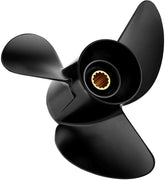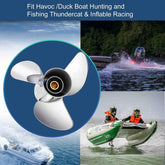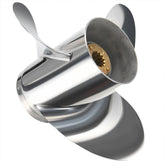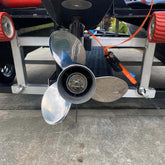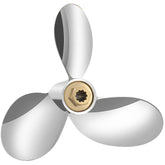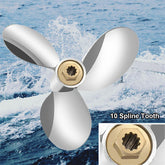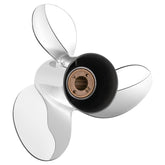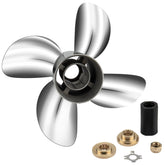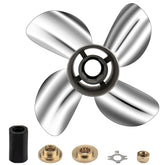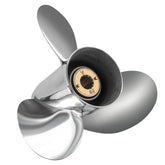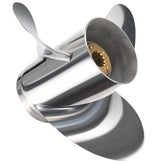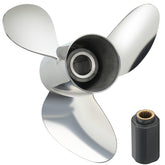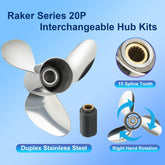Best Outboard Propeller Replacements for Mercury and Yamaha: Fitment, Testing, and Affordable Stainless Alternatives
I speak as a propeller technician who has tuned and repaired hundreds of outboards across North America. This guide is practical and field tested. It explains exactly what facts to confirm before you buy, how to run an on the water test that produces actionable data, starter prop picks by horsepower band, the tradeoffs between aluminum and stainless, how to diagnose common failures, and an ordering workflow that gets the right prop to your ramp quickly from vifprop.com.
We are not Mercury or Yamaha official. We manufacture compatible propellers that match the common spline and hub standards used by Mercury, Yamaha, Honda and Volvo. Choosing the correct SKU and validating fit with a short test on the water separates a good purchase from an expensive return. If you want to learn more about how our boat propellers are produced and understand the capabilities of our factory, read this article https://vifmarine.com/how-boat-propellers-are-manufactured/
Why this comparison matters today
Mercury and Yamaha dominate the North American outboard market. Both brands offer well engineered OEM propeller lines and selector tools. Those selectors are useful, but they assume a test hull, a controlled load, and ideal conditions. Real owners carry passengers, batteries, coolers, and tow toys. Real boats operate in waves, wind, and varying trim settings.
This reality changes which propeller performs best. For most owners the practical questions are these
Which propeller will get my loaded boat on plane quickly
Which propeller will keep my engine in the recommended wide open throttle range
Which propeller gives a reliable feel with minimal vibration
Which option lets me test and tune without spending more than the boat is worth
Factory direct stainless and well built aluminum alternatives answer those questions at a realistic price. The rest of this article tells you how to get fitment correct, measure results, and order the right propeller from vifprop.com.
The single most important checklist before you buy
If you do one thing before placing an order, do this. Confirm these five facts from the transom tag or from the old propeller hub
Engine make, model and model year exactly as shown on the transom tag
Gearcase code from the transom tag because different gearcases can use different spline counts and hub types
Spline count and hub type such as Flo Torq style elastomer insert or a splined bore
Rotation, meaning right hand, left hand, or counter rotating
Washer and thrust plate sequence because incorrect order can cause hub slip and premature wear
If any of these items is unclear, remove the prop and take clear photos of the hub and splines. Send the photos to the seller for verification before ordering. That precaution is the fastest way to avoid returns.
How hub systems actually differ between Mercury and Yamaha
Mercury commonly uses Flo Torq elastomeric insert hubs across many gearcases. The Flo Torq system isolates shock and slip and has a specific insert profile and spline count. Yamaha more frequently uses a solid splined bore with precise spline counts. Solid splined setups and Flo Torq setups are not interchangeable without the correct hub or adapter.
Compatibility claims need to list the exact gearcase codes and spline counts. A product that says it fits Mercury or Yamaha without that detail is a risk. Always match the SKU to your transom tag data.
The shop rules that determine real world performance
Pitch is the primary tuning lever. Pitch determines whether your engine will reach the recommended wide open throttle range with your normal load.
Diameter controls low end thrust. Larger diameter moves more water per revolution and increases low RPM bite.
Blade area and blade count trade top speed for bite. Adding blade area or blades improves hole shot and planing under load. Reducing blade area favors top speed on a light boat.
Cupping adds low speed bite and resists ventilation. Rake influences bow lift and can help a hull break onto plane earlier.
Slip gives objective feedback. Use slip together with wide open throttle information to choose pitch.
If a replacement propeller does not bring WOT RPM into the engine maker recommended band for your loaded boat, the pitch is wrong no matter which brand name is stamped on the blade.
Two formulas you will actually use on the water
Theoretical speed in miles per hour equals pitch in inches multiplied by engine RPM divided by 336
Slip percentage equals one minus GPS speed divided by theoretical speed multiplied by 100
For planing hulls aim for roughly ten to twenty five percent slip. Use this number in combination with WOT RPM to make decisions.
On the water testing workflow used by professional tuners
Follow this exact workflow each time you change a propeller. It removes guesswork and produces repeatable data.
Prepare the boat. Clean hull growth, set trim tabs to the position you normally use, and fuel to your typical level. Test with your normal passengers and gear.
Warm the engine to operating temperature. Cold numbers are not reliable.
Run two or three wide open throttle passes in similar conditions. Record tachometer and GPS for each pass and average the results.
Compute theoretical speed and slip using the formulas above.
Interpret and act. If wide open throttle RPM is below the engine recommended band the pitch is too tall. Reduce pitch by one inch and retest. If RPM is above the band increase pitch and retest. If the boat will not plane but RPM is in the band increase blade area by switching to a four blade or a cupped three blade.
Iterate with one inch pitch changes and blade count swaps until WOT RPM, slip and planing feel meet your goals.
Always test with your normal load. Empty boat testing often misleads.
Starter propeller recommendations by horsepower band
These are starting points to order and test. Always verify SKU compatibility on the product page before purchase.
Five to fifteen horsepower. Start with eight by eight three blade aluminum.
Twenty to forty horsepower. Start with nine by ten three blade aluminum.
Fifty to ninety horsepower. Test eleven and a half inch diameter by fifteen inch pitch stainless as a baseline. Bring an aluminum spare and a four blade option to test.
One hundred fifteen to one hundred fifty horsepower. Start with fourteen inch by nineteen inch stainless for speed and a four blade for loaded planing.
One hundred seventy five to three hundred plus horsepower. Test fifteen to seventeen inch diameter props with nineteen to twenty five inch pitch. Evaluate cleaver and high rake variations for high RPM runs.
If budget allows order a baseline prop plus a one inch lower pitch or a four blade variant. Buying two props up front reduces multiple returns and speeds tuning.
Aluminum versus stainless explained in clear terms
Aluminum is cost effective and sacrificial. It bends on impact and often protects the lower unit. Aluminum blades have thicker sections which reduce peak efficiency but make them a good trailer spare for shallow or debris prone ramps.
Stainless allows thinner, more hydrodynamic blade sections that return measurable gains in top speed and cruise efficiency. Stainless holds its edge and lasts under repeated use. Stainless transmits impact energy to the lower unit more directly and historically cost more. Modern factory direct stainless closes that price gap and makes iterative testing realistic.
A practical approach for most owners is stainless for daily use and an aluminum spare on the trailer.
Blade counts and designs that change how your boat feels
Three blade propellers give the highest potential top speed for a given pitch and diameter and are the baseline for performance oriented setups.
Four blade propellers increase blade area and improve hole shot and planing under load. The tradeoff is a small top speed reduction. Four blades are often the right choice for pontoons, tritoons, family boats and towing.
Cleaver and high rake three blade options are for high RPM runs and require adequate skeg clearance and correct gearing.
If your boat struggles to plane with its normal load and WOT RPM sits in the recommended band switch to a four blade and retest. You will typically plane faster and gain usable speed in the conditions you actually run in.
Common buyer traps and how to avoid them
Do not rely on a vague fits claim. A fits claim is only useful if it lists the gearcase codes and spline counts.
Do not assume rotation. Single engines are usually right hand. Twins often use a counter rotating pair.
Do not ignore washer and spacer order. Wrong washer sequence can cause hub slip and accelerate wear.
Photograph the hub and spline count and copy the gearcase code before purchasing. Use those facts to match the SKU on the product page.
Diagnostic playbook for strikes, spun hubs, bent blades and lower unit damage
If you strike something stop the engine and shift to neutral immediately.
Inspect and photograph blades, hub, splines and the lower unit. Photographs speed up shop estimates and warranty claims.
Check lower unit oil for metal flakes or milky discoloration. If either is present do not run the engine. Tow it to a service shop.
Symptom decode. Engine revs but boat will not move equals a spun hub or stripped splines. Vibration at cruise equals a bent blade or imbalance. Grinding noises and metal in oil equals gearset or bearing failure. Loss of top speed with normal RPM equals blade deformation or heavy fouling.
DIY triage steps. Remove the propeller to inspect the elastomeric hub and splines. Replace a shredded hub insert. Measure propeller runout on a bench. Small aluminum bends can often be straightened and dynamically balanced. If splines are stripped, the shaft is bent or stainless is cracked call a professional.
Typical cost ranges. Hub insert kits range from fifteen to sixty dollars. Aluminum prop straightening and dynamic balancing typically cost thirty to eighty dollars. Stainless replacement pricing commonly ranges from two hundred to seven hundred dollars. Lower unit rebuilds typically range from five hundred to three thousand five hundred dollars depending on parts and labor.
Keep a spare aluminum prop and a hub insert kit on the trailer to avoid weekends ruined by simple failures.
Why factory direct manufacturing changes the tuning equation
Factory direct stainless often comes in thirty to fifty percent below OEM stainless pricing. CNC finishing and dynamic balancing increase consistency between parts. U S warehousing and a one hundred eighty day manufacturing warranty reduce lead time and return friction.
For tournament anglers, fleet managers and rental operators buying several stainless test props and iterating on the water is the fastest route to a tuned setup. Modern factory direct sourcing makes that approach affordable for more boaters.
How to use manufacturer prop selector tools the right way
Manufacturer selectors are useful starting points. Use them to find the OEM baseline for your engine and boat type and to record the stock diameter, pitch and blade count along with the gearcase code.
Order the baseline for guaranteed fitment then buy one inch lower pitch or a different blade count to test. Run the on the water workflow with your normal load. Select the propeller that lands wide open throttle RPM in the engine maker recommended band while delivering acceptable slip and the planing feel you want.
Your actual load, trim and hull condition are the final judges, not the selector recommendation.
Exact steps to order the right propeller on vifprop.com
Pull the current propeller and photograph the hub and splines or copy the transom tag data.
Go to vifprop.com and use the compatibility matrix on the product page to find SKUs that list your engine and gearcase code.
Confirm engine model, gearcase code and spline count match the SKU. Upload photos via the live chat if you want verification before checkout.
Add the baseline propeller plus one inch lower pitch or a four blade variant to the cart and include an aluminum spare if you run shallow launches.
Choose U S warehouse shipping at checkout for fastest delivery.
When the props arrive install the baseline and run the on the water test workflow. Keep packaging until you are satisfied in case a return is needed under the warranty.
Ordering two props up front saves time and reduces multiple returns.
Frequently asked questions answered directly
Will a compatible propeller damage my Mercury lower unit
Not if you select the correct SKU that matches the gearcase code and spline count. Damage comes from impacts, wrong washer order and running with contaminated oil, not from a properly matched propeller.
How fast will shipping be
Choose U S warehouse shipping at checkout. Most orders ship the same or next business day and delivery times are shown at checkout.
What if I order the wrong propeller
Vifprop offers a clear returns policy and a one hundred eighty day manufacturing warranty. Keep packaging and document fit attempts. Use live chat for fast help.
Can I test a stainless and return the one I do not want
Yes. Keep the propeller unused in its packaging and follow the return instructions on the product page.
Does VIF support Flo Torq type hubs and common Yamaha splines
Yes. Each SKU lists hub compatibility including Flo Torq style inserts or splined bore and spline count. Confirm your engine and gearcase code before ordering.
Final expert checklist take action now
Photograph your transom tag and old propeller hub
Confirm engine model and gearcase code
Order the OEM baseline and one inch lower pitch stainless or a four blade variant plus an aluminum spare at vifprop.com. Select U S warehouse shipping
Run two to three wide open throttle passes with your normal load and compute slip
Keep packaging and photos until you are satisfied and use live chat if anything looks off
Keep a spare propeller and a hub insert kit on the trailer to avoid weekend failures
If you want immediate help selecting the exact SKU paste your transom data and a photo of the old propeller hub into the vifprop.com site chat. Support will confirm the correct product before you check out.


